A Complete B2C Email Marketing Guide with Examples
We’re excited to welcome you to another great article where you’ll learn all about B2C email marketing. We'll cover the best practices, explore what makes B2C email marketing different from B2B email marketing, and guide you on how to create an email list for your B2C campaigns. We've put a lot of effort into this article, and we hope you find it useful and apply it to your campaigns.
Emails in marketing are not just simple messages; they serve as powerful tools to enhance sales and present your business to potential clients. When crafting your email strategies, choosing the approach that best aligns with your business needs is essential.
Create your template using our email template builder.
B2C email marketing is a key e-commerce marketing method that enables you to direct communicate with your customers or clients. This approach, known as "Business to Consumer," allows you to sell products or services directly to the end user, bypassing distributors. Using B2C email marketing examples, you can effectively target your audience and secure significant sales and revenue.
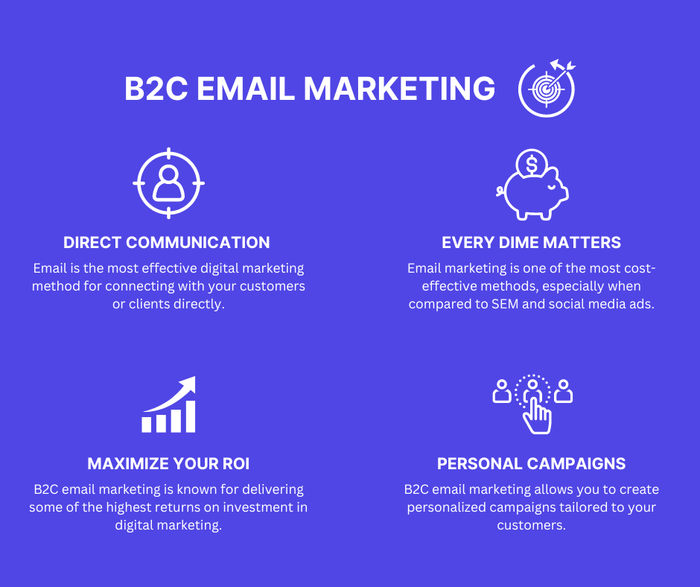
Should You Invest in B2C Email Marketing?
One of the key distinctions of B2C email strategies compared to others is that B2C is designed to engage the customer directly. This approach involves additional strategic steps, which means you can potentially gain more benefits than by selling your products or services through an intermediary.
Writing the best email subject line for sales, building your brand with color psychology to evoke emotions in your customers, and designing the perfect CTA for emails to convert sales are all crucial steps for your email marketing success.
It may seem overwhelming trying to get everything right and not miss a single detail, but let me assure you, you don’t have to be perfect. There's no one-size-fits-all solution, you’ll discover the right approach as you go. As long as you care about your brand and customers, you’re on the right path. And remember, Tabular is here to help you create beautifully designed email templates for every situation. So, what are you waiting for? Try one of our designer email templates for free today!
Create your template using our email template builder.
By leveraging emotional appeal and persuasive skills, you can establish a stronger connection with your customers, ultimately leading to greater success. Here are some advantages of using B2C email marketing examples:
Automation: With the growing use of B2C communication in marketing, various AI tools have been integrated into email templates.
These online tools allow you to use automate B2C email lists to promote your company's products and services to individual customers. Additionally, automation tools enable you to track customer data, such as purchasing behavior, abandoned carts, and email open rates.
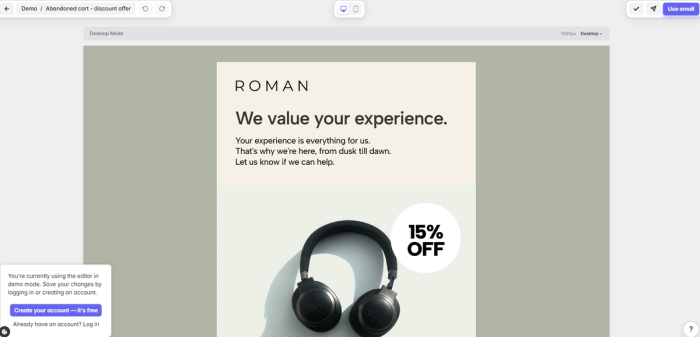
Cost-Effectiveness: Email marketing is one of the most widely used mediums in marketing strategies. According to Forbes, 64% of small businesses use email marketing to reach customers.
Email marketing is already highly profitable, so you can adopt the most effective techniques. The B2C email marketing strategy offers the highest ROI (return on investment) among various approaches. You can discover the most profitable email marketing method by simply creating and testing email templates.
Global Reach: Email marketing relies on your ability to communicate directly with customers. To achieve successful sales, it's crucial to recognize your global potential. By using email marketing lists, you can leverage customer decisions and touchpoints to reach the most interested customers worldwide.
Tiered Pricing: B2C marketing strategies are adaptable to a wide range of businesses. Email marketing platforms allow for easy automation of campaigns, enabling businesses to reach thousands of customers with just a few clicks. This scalability reduces the need for large teams or additional resources, keeping operational costs low.
B2C vs. B2B Email Marketing
One of the most frequently asked questions in e-commerce marketing is about the differences between B2B and B2C email marketing strategies. To investigate this further, let’s explore these distinctions.
There are several key differences between B2B and B2C marketing strategies, particularly in target audience, sales cycle, content, and design.
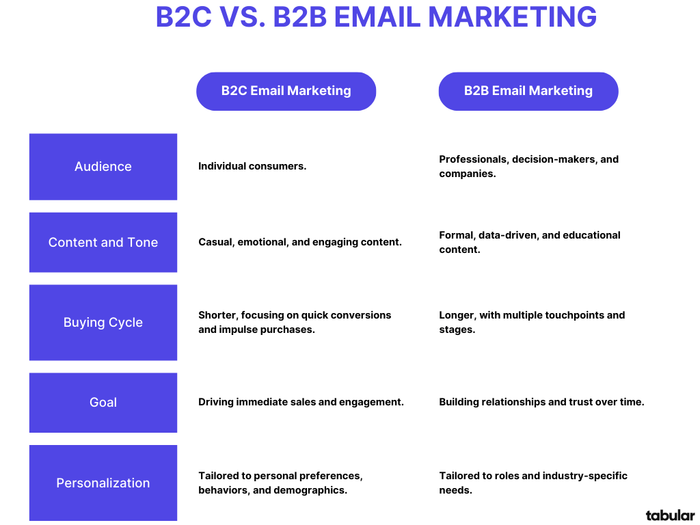
Target Audience
B2B: Your audience consists of knowledgeable stakeholders already familiar with your products. Therefore, you won’t need to provide in-depth details about your offerings. Communication will primarily be with professionals, decision-makers, or other organizations.
B2C: You will be engaging with everyday individuals who may not have prior knowledge of your product or service. You can adopt a more personal and genuine tone when reaching out to consumers or households.
Sales Cycle
B2B: The sales cycle for your products or services tends to be longer and more complex. Since you’re offering products or services to a business, you’ll need to be more persuasive and conduct thorough research to determine the best sales approach, which often involves multiple financial departments.
B2C: Your goal is to prompt customers to purchase your product or service, allowing for a more direct and action-oriented approach. Using an effective subject line for your sales email is crucial at this stage.
Research indicates that the average B2C sales cycle typically concludes within one to two weeks, while a B2B cycle usually extends over a month.
With B2C cold email templates, you can focus primarily on improving your click-through rates (CTR).
Content
B2B: When selling to businesses or other professional organizations, your content should be more detailed and technical, incorporating data or statistics highlighting your product’s benefits and success.
B2C: Your content can be simpler and more genuine in tone, using everyday language to emotionally connect with your target audience. Since the process is generally quicker, your choice of banner fonts and CTA text in your email holds the greatest value.
Design
B2B: Think of your emails as business presentations. Therefore, the design should be more corporate, with clear and focused navigation.
B2C: When it comes to capturing micro-moments, the UI of email template is extremely important. Your emails should feature eye-catching design elements, such as creative and aesthetically appealing images or animations. Colorful and exciting call-to-action (CTA) buttons are essential for capturing attention from the outset. Also, remember that using color psychology in your email templates to evoke emotions is crucial.
Types of B2C Email Marketing Campaigns
To achieve the most effective results from your B2C email marketing campaigns, it's essential to understand the different types of emails you can use.
Create your template using our email template builder.
Running an email marketing campaign without using templates is a real challenge, believe me. With ready-to-use templates, you can easily target customers at different stages of customer journey. Here are some of the most important types of emails you may want to include in your email mapping:
1. Welcome Emails
Welcome email templates are sent to recipients when they subscribe to your email list or sign up on your website.
This is your chance to make a strong first impression by using an email template that reflects your brand identity and business objectives. You can also automate these welcome emails to make sure that anyone who interacts with your services for the first time receives a warm greeting.

2. Abandoned Cart Emails
Abandoned cart email templates are crucial for recovering potential lost sales. Some customers may forget about items in their cart or hesitate to make a purchase.
Sending targeted campaigns to remind them of their abandoned carts can be highly effective. Research on cart abandonment statistics shows that over 40% of these emails are opened, with click rates reaching up to 45%, and 50% of those who clicked went on to complete their purchase.
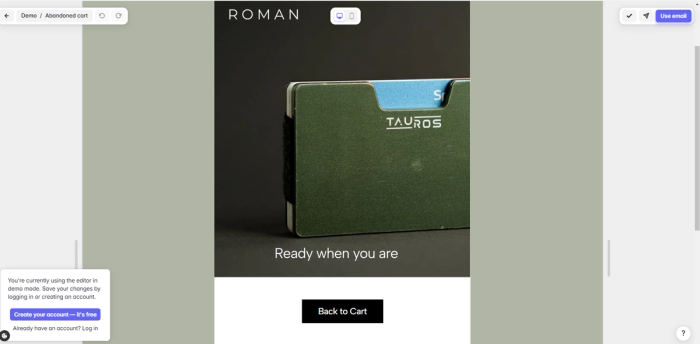
3. Customer Loyalty Campaigns
Maintaining strong relationships with customers is a top priority in B2C email marketing. As you continue to make sales, it's important to recognize and reward loyal customers. Sending customer loyalty campaigns, such as exclusive discounts, personalized offers, or special access to new products, can encourage repeat purchases and strengthen the bond between your brand and your customers.
Email template builders like Tabular allow you to create email templates for each stage of the customer journey. With these templates, you can turn this one-time process into a money-making machine without any hassle.
Create your template using our email template builder.
4. Re-Engagement Emails
At some point in the email marketing customer journey, users may stop engaging with your brand. Re-engagement emails are designed to win back these inactive customers. A study on reactivation emails found that a well-executed reactivation campaign achieved a 29% win-back rate for a retail client.
5. Reminder Emails
Even though your customers have access to your offerings, they may forget about special promotions or sales. Sending reminder emails helps keep your campaigns top of mind and encourages customers to engage with your offers.
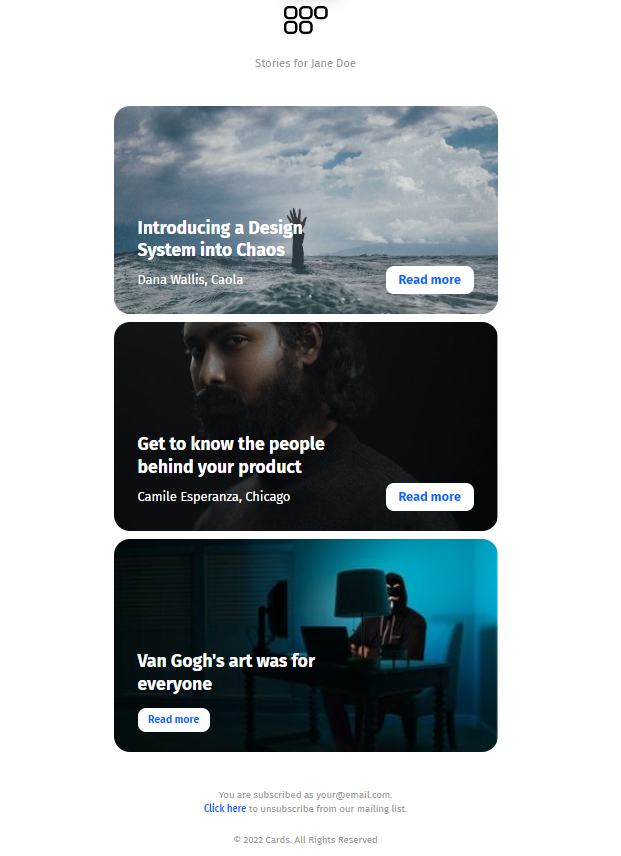
6. Newsletters
Weekly newsletters are a common B2C email marketing strategy. By sharing articles about new products, services, or educational blog posts, you can keep your customers engaged while driving traffic to your latest content. To avoid overwhelming your audience, consider scheduling these newsletters on a weekly basis.
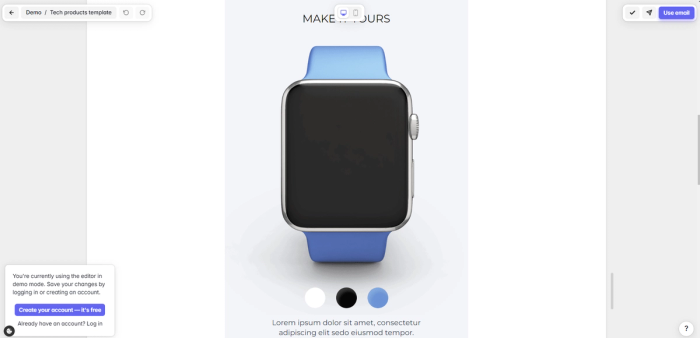
7. Win-Back Campaigns
For customers who have stopped purchasing from your website, win-back campaigns can be an effective way to encourage them to return. By personalizing your emails with product or service recommendations aligned with their interests, you increase the likelihood of re-engaging these customers.
8. Special Offers
Building a close relationship with your customers allows you to connect with them on a more personal level. Acknowledging special occasions, such as birthdays, with special offers can strengthen this relationship.
For effective B2C email campaigns, incorporating personalized special offers can yield excellent results.
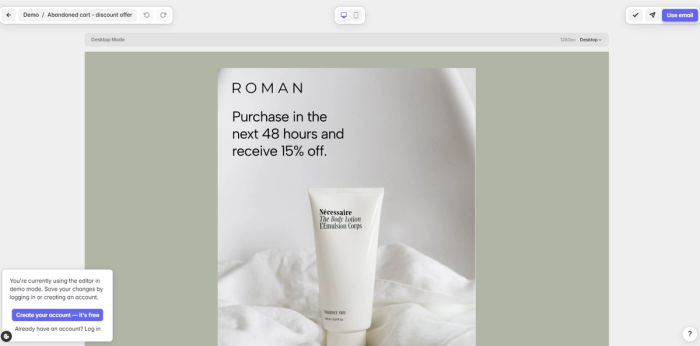
9. Thank You Emails
Always remember to express gratitude to your customers for supporting your business. Thank-you emails not only show appreciation but can also serve a practical purpose by including order details. This combination of gratitude and functionality makes thank you emails a valuable tool in your B2C marketing strategy.
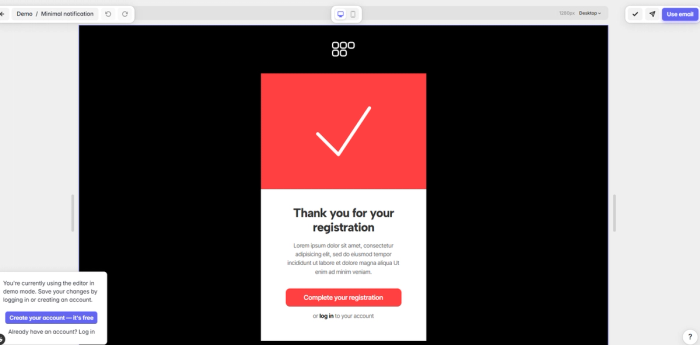
How to Create a B2C Email Marketing Campaign That Works
Identify Goals
First thing first, you need to define your goals investing in this campaign. You can expand your email list and reach out to a wider audience who might be interested in your products or services.
You can use B2C email marketing strategies to increase engagement. In email marketing, the ultimate goal is to create interaction to your website or online-store.
Having multiple goals for different stages of the customer journey in your email mapping is crucial for shaping effective email marketing campaigns. This way, you'll be able to detect unsuccessful strategies and create campaigns that work.
Build and Segment a Mailing List
B2B email lists can help you to get in touch with a wider audience. However, you should also care about the open rates of your emails.
Low open rates might mean that your customers are not interested in your product or service. You should segment your email list and create personalized email templates. In fact, research on email marketing statistics shows that segmented email campaigns have an open rate 14.31% higher than non-segmented campaigns.
Another reason your open rates may be struggling could be the subject lines. Users open emails based on the subject lines and convert into leads or purchases through the design of your email, especially your email CTAs.
Decide on the Types of Emails
The foundation of your email marketing strategy begins with selecting the types of emails that align with your business goals and customer journey.
Common types of B2C emails include:
Consider Email Automation
Email automation is a powerful tool that can significantly enhance the effectiveness of your campaigns.
Automated emails allow you to send targeted messages based on specific triggers or customer behaviors in your email map, such as a welcome email immediately after sign-up or a thank-you email after a purchase.
Automation not only saves time but also provides your customers with timely and relevant content. According to recent data, automated emails generate 320% more revenue than non-automated ones.
Set Email Frequency and Timing
Finding the right balance in email frequency within your customer journey mapping is crucial to avoid overwhelming your customers or becoming irrelevant. Consider your audience’s preferences and behaviors when setting your email timing.
For instance, sending too many emails can lead to higher unsubscribe rates, while sending too few can result in lost opportunities. Testing different frequencies and times of day can help you determine the optimal schedule that maximizes engagement.
Monitor Key Metrics
Tracking key metrics is essential to measure the success of your email campaigns and identify areas for improvement. Some of the most important metrics to monitor include:
Open Rates: Indicate the effectiveness of your email subject lines and timing.
Click-Through Rates (CTRs): Reflect how engaging your email content is and how well your email CTAs perform.
Conversions: Measure the ultimate success of your campaign in driving sales or leads.
Create your template using our email template builder.
Optimize with Email Templates
Using email templates can provide your brand with consistency and save significant time. Templates allow you to maintain brand identity and adhere to best practices while making it easier to test and optimize different parts of each email.
Using an email builder gives you an even greater advantage in designing your email marketing campaigns.
With Tabular, you can select from our collection of free email templates and customize them using our email editor.
Best Practices for B2C Email Marketing
When it comes to email marketing, mistakes can lead to unwanted results more often than not. This is one of the downsides of directly contacting your customer base. It’s important to comply with B2C email marketing best practices if you don’t want to end up in the spam folder.
1. Prioritize Customer Needs
Customers and clients are the best marketing advisors if you know how to listen to them.
A/B testing different subject lines for sales can skyrocket your profits, as well as choosing the right banner font that adapts to the languages of your customers. Don't forget that the common ground your customers share is their need for your service or product, but they still differ in many ways. Choosing the right emails to target specific groups always leads to success.
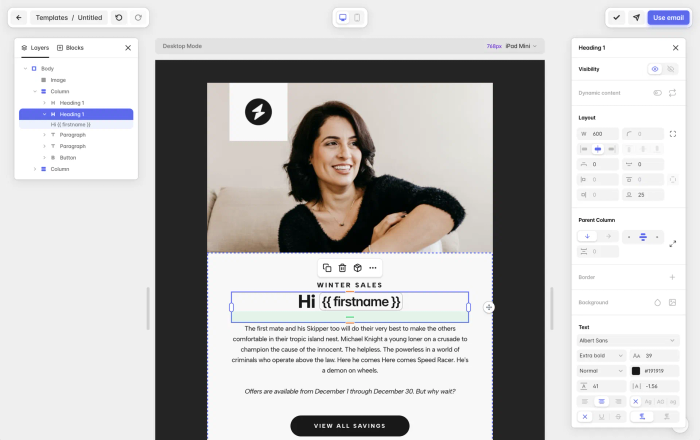
2. Personalize Emails
Personalizing emails allows you to directly address your customers' specific needs or special occasions.
B2C email marketing statistics show that personalized subject lines are 26% more likely to be opened.
A simple way to personalize your emails is by addressing recipients by name, making your communication feel more personal and sincere.
3. Use Responsive Templates
According to TechReport, 85% of users check emails on mobile devices. Even if you design your email templates on a computer, it's crucial to consider mobile devices and various screen sizes.

Creating responsive and mobile-optimized templates will benefit you in the long run.
With Tabular's email editor, you can build responsive email templates that work seamlessly across all email service providers and devices.
4. Focus on Deliverability
A key factor in email marketing success is making sure that your emails reach to the inboxes.
At this step, it's essential for your B2C email list to be functional and segmented. Additionally, designing your visuals and crafting your subject lines thoughtfully can help prevent your emails from landing in the spam folder.
5. Create a Sense of Urgency
One effective tactic for creating a successful B2C email template is to create a sense of urgency in your email subject line or main content.
Research on email subject lines shows that including urgency can lead to a 22% increase in open rates. This psychological trick can significantly enhance the effectiveness of your email marketing strategy.
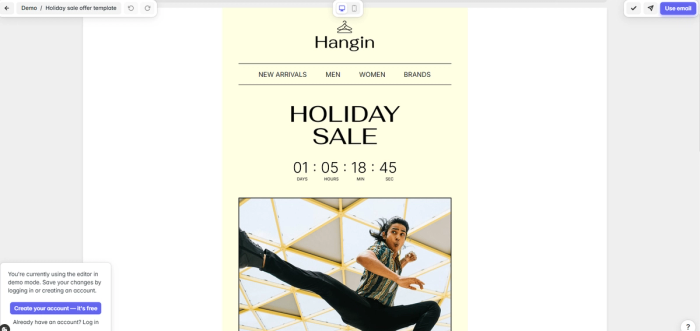
6. Design Strong CTAs
As discussed in the comparison between B2B and B2C email marketing, when directly engaging with your customers, it's essential to use compelling subject lines to capture their attention.
After the user opens your email, the element that will drive leads or sales is your email CTA buttons. Eye-catching visual elements, such as bold colors or subtle animations, can make your CTAs more noticeable and guide customers toward your desired outcome more effectively. Strong CTAs are crucial for driving the success of your email campaign.

7. A/B Testing
Regular testing is essential for your email campaign remains effective and up-to-date. You can determine which version performs better by segmenting your B2C email list and sending different sets of email templates to each segment.
Create variations in visuals or wording for the templates and send them to different test groups. You can identify the most successful approach by comparing metrics such as open rates and click-through rates (CTRs).
Research indicates that A/B testing of email subject lines can result in a 28% higher return on investment (ROI), underscoring the value of continuous optimization .
8. Maintain Email Etiquette
Regardless of who you’re communicating with, it’s important to remember that email is a formal and documented form of communication. Adhering to proper email etiquette when engaging with your customers shows respect for their time and privacy. Simple practices like addressing recipients politely, keeping your message clear and concise, and avoiding overly aggressive language can go a long way in fostering positive relationships and building trust with your audience.
B2C Email Marketing Examples
Understanding effective marketing strategies is often easier by reviewing successful examples. Let’s take a look at one:
Decofurn
Decofurn is an online furniture retailer. has effectively leveraged B2C email marketing to reach and engage its customers. Their success can be attributed to several strategies we've discussed. First, they use high-quality images of their products, which immediately convey the premium nature of their furniture and attract potential buyers.
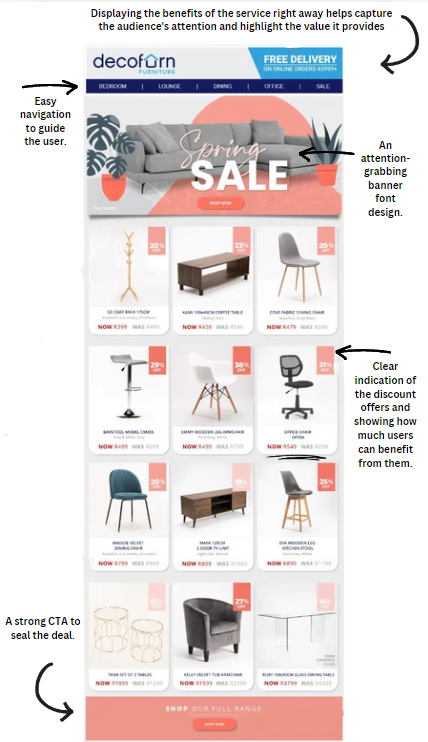
In their emails, Decofurn strategically places promotions and sales in the header, the first section customers see.
For example, they prominently feature a free delivery offer at the top of their emails, which instantly greets customers with a benefit that grabs their attention. They also include timely, urgency-driven discounts, prompting customers to act quickly, which increases engagement and conversion rates.
One of Decofurn’s most effective tactics is its use of attention-grabbing CTAs. They employ visually appealing elements, such as bold colors and simple yet powerful wording, to attract customers. These CTAs are designed with color psychology to make sure that they stand out and drive action.
Conclusion
In conclusion, B2C email marketing is a powerful tool for businesses aiming to engage directly with customers and drive sales.
By personalizing your content, strategically designing templates with color psychology, strong CTAs, and utilizing automation, businesses can nurture customer relationships and increase conversion rates.
The key to success lies in understanding your audience, delivering relevant messages, and continuously optimizing your approach through testing and tracking metrics.
B2C email marketing offers endless opportunities to connect with your audience and grow your brand.